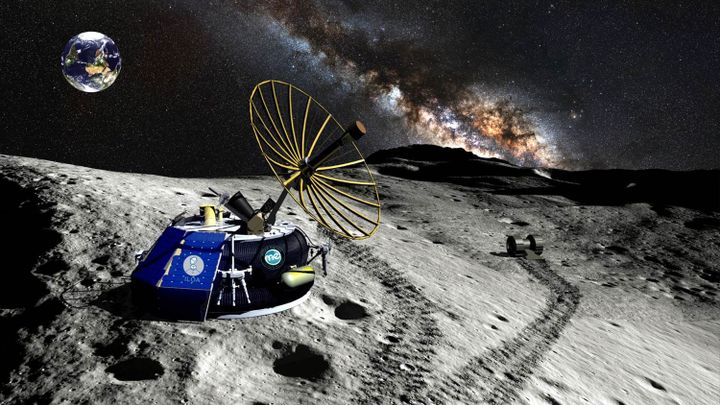
It's hard to believe it's been more than 45 years since we landed humans on the moon. But a generation and a half after Neil Armstrong and Buzz Aldrin touched down on the moon in 1969, the Apollo missions of the era are still hailed as one of the great technological feats of at least the past century (if not all time.) Those missions still inspire the youngsters of today to get involved in space exploration.
To be clear, exploration of the moon continues -- even though humans aren't there personally to get dirty in the regolith. NASA has a long-running mission there called the Lunar Reconnaissance Orbiter that, among other things, took pictures of the Apollo landing sites. Roughly 18 months, China landed a rover-lander combination (Yutu and Chang'e-3, respectively). And in the past few decades, other space agencies have checked out the moon as well -- India, Europe and Japan among them.
But this is where it gets interesting: so far, we've only been talking about government space agency exploration. Could a company or a small group of dedicated people do the same thing? It doesn't seem too crazy now in this era of SpaceX Dragons and Orbital Cygnuses supplying the International Space Station. And indeed, the Google Lunar XPRIZE hopes to see a commercial company on the moon. ASAP.
And time is running short for those teams, given the deadline to get there is Dec. 31, 2016 -- only 1.5 years from now. This is what the winning team has to do to win the grand prize of $20 million: get a robot on to the surface, move 500 meters on or above or below the surface, and then transmit an HDTV "mooncast" to those stuck at home on Earth. (If they manage to do that latter, they will even beat the feats of Apollo 12; those astronauts lost their camera shortly after beginning their moonwalk after a crew member accidentally pointed out towards the sun.) Extra incentive prizes are available for arriving at an Apollo site or getting through the long lunar night, for example.
"We’re going back to the moon. For good," the Google Lunar XPRIZE website reads. "Why? Our Moon -- the ‘eighth continent’ -- has a land area larger than Brazil and North America put together ... and people have only been to 5% of it! There are amazing natural wonders, valuable resources, and unsolved mysteries waiting to be discovered."
"Unfortunately," the site continues, "getting to the moon hasn’t been very cost-effective -- yet. And that’s where the Google Lunar XPRIZE comes in: $30 million in prizes designed to inspire pioneers to do robotic space transport on a budget. Teams from around the world are well on their way to accomplishing this and ushering in a new era of space frontiers!"
There are some who may ask why it would be worth it to go back to the moon after having sent several humans there a few decades ago. The short answer is since that time, we've learned so much more about our closest large neighbor. We've discovered water ice -- yes, water ice -- in the coldest craters, shielded from the sun. There's a mystery of hovering dust that takes place at the border of sunlight and shadow. And in general, looking at the moon will teach us more about our own origins; after all, looking at other places in the solar system gives us context about our own planet, Earth.
The competition -- sponsored by Google and hosted by the XPRIZE Foundation (which HeroX co-founder Peter Diamandis created) -- was announced at the Wired Nextfest in September 2007. Teams had the next three years to consider whether to register, as the deadline closed in 2010. In the intervening years, a few teams have won milestone prizes, but the grand prize is obviously still up for grabs.
Much like a survival of the fittest competition, teams have been fighting to stay alive through the various milestones. The initial entries included teams from all over the world -- spots as far-flung as Italy and Israel and Japan. While only 16 teams remain now, their diversity of nationalities remain impressive. It shows you don't have to be from the U.S. anymore to dream of touching the moon.
Will any of the teams actually get there in time? In February, a news release came that gave moon explorers some hope: Hakuto (from Japan) and Astrobotic (in the United States) announced that they would launch a joint mission in the second half of 2016, on a SpaceX Falcon 9 rocket. It's all the more interesting since both teams have received incentive prizes for mobility (Hakuto, $500,000) and landing, mobility and imaging (Astrobotic, $1.75 million). The rovers from these teams have cute names as well -- Moonraker, Tetris and Andy.
"The target area for this landing will be the Lacus Mortis region, located in the northeastern part of the moon," the press release read. "Images from spacecraft orbiting the moon suggest that Lacus Mortis holds a pit or a skylight, and could potentially be an entrance to a lunar cave. These caves are thought to be lava tubes and could prove scientifically important in explaining the moon's volcanic past. Longer-term, they have potential to house habitats that would protect humans from the hostile lunar environment."
To stay tuned to the latest in the Google Lunar XPRIZE competition, you can follow their journey on social media (you can view the various networks at the top right-hand side of this page.) Whether you're watching on YouTube or picking up updates on the bus through Twitter, you can be sure it will be an exciting 18 months as teams race for the grand prize.
Top image: Moon Express' concept for the Google Lunar XPRIZE. Credit: Moon Express








